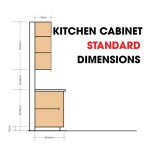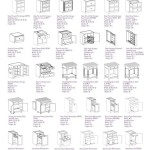What Size Should Kitchen Handles Be? A Comprehensive Guide
Choosing the right size kitchen handles can significantly impact the aesthetics and functionality of a kitchen. While personal preference plays a role, adhering to established guidelines and considering various factors ensures handles are both visually appealing and comfortable to use. This article provides a detailed overview of determining appropriate kitchen handle sizes for cabinets and drawers.
The selection of kitchen handles extends beyond mere decoration. The size, style, and finish contribute to the overall design theme and affect the ease of opening and closing cabinets and drawers. Undersized handles can be difficult to grip, while oversized handles may appear disproportionate and visually overwhelm the cabinetry. Therefore, a thoughtful approach is necessary to achieve a harmonious balance between form and function.
Understanding Standard Handle Sizes
Kitchen handles are typically measured by their center-to-center distance, which is the distance between the screw holes. This measurement is crucial for ensuring proper installation and a uniform appearance throughout the kitchen. Common standard sizes include:
Single Hole Knobs: These are often used for smaller drawers and cabinets. They do not have a center-to-center measurement as they are secured with a single screw.
3-inch (76mm) Center-to-Center: This size is frequently used for smaller drawers, typically those under 12 inches in width. They offer a compact and discreet appearance.
3.75-inch (96mm) Center-to-Center: Another common option for drawers and cabinets, this size provides a slightly larger grip than the 3-inch handle.
5-inch (128mm) Center-to-Center: This size is suitable for medium-sized drawers and cabinets, offering a comfortable grip and a balanced aesthetic.
6.3-inch (160mm) Center-to-Center: Often used for larger drawers and cabinets, this handle size provides ample grip and a more substantial visual presence.
Larger Sizes (7.5-inch and above): These are generally reserved for very large drawers, pantry doors, or appliances. Their larger size ensures easy access and a strong visual statement.
It is important to note that these are general guidelines, and the optimal size might vary depending on the specific design and dimensions of the cabinetry.
Factors Influencing Handle Size Selection
Several factors should be considered when determining the appropriate size for kitchen handles. These include drawer and cabinet size, style preference, and accessibility needs.
Cabinet and Drawer Size: The dimensions of the cabinets and drawers are the primary determinants of handle size. Smaller drawers typically require smaller handles to maintain visual balance. As the size of the drawer increases, so too should the handle size.
Style Preference: The overall style of the kitchen influences handle selection. Modern kitchens often feature sleek, minimalist handles, while traditional kitchens may incorporate more ornate and substantial designs. The chosen style will dictate the acceptable range of handle sizes.
Kitchen Layout and Accessibility: Consider the kitchen layout and user needs. For households with elderly individuals or those with limited mobility, larger handles are often preferred as they provide a more secure and comfortable grip. The placement of appliances and cabinet configurations may also influence the choice of handle size to ensure ease of access.
Proportion and Balance: Achieving visual harmony is crucial. The handle size should be proportionate to the size of the drawer or cabinet. Avoid undersized handles that appear insignificant or oversized handles that overwhelm the cabinetry.
Handle Style: Different handle styles (e.g., pulls, knobs, cup pulls) have varying visual weights. A chunky knob may appear larger than a sleek pull with the same center-to-center measurement. Consider the visual impact of the chosen style when determining the appropriate size.
Finger Clearance: Confirm adequate finger clearance behind the handle. A handle that is too close to the cabinet or drawer face can make it difficult to grip and open, especially for individuals with larger hands. Consider the projection of the handle when making your selection.
Consistency: While variations in handle size can be used strategically, maintaining a degree of consistency throughout the kitchen creates a unified and cohesive look. Decide whether you prefer to use a single handle size, a combination of sizes, or different styles for different applications.
Practical Guidelines for Choosing the Right Size
Applying some practical guidelines can help simplify the selection process and ensure optimal results. These guidelines offer a starting point for determining appropriate handle sizes for various cabinet and drawer configurations.
Drawers Under 12 Inches Wide: Single knobs are a popular choice for small drawers. Alternatively, handles with a 3-inch or 3.75-inch center-to-center measurement can be used.
Drawers Between 12 and 24 Inches Wide: Handles with a 5-inch center-to-center measurement typically work well for drawers in this size range. Alternatively, two smaller knobs or pulls can be used, positioned equidistant from the center of the drawer.
Drawers Between 24 and 36 Inches Wide: Handles with a 6.3-inch center-to-center measurement or larger are often preferred for wider drawers. Consider using two handles for a more balanced appearance and improved functionality.
Drawers Over 36 Inches Wide: Large drawers require substantial handles to ensure easy opening and closing. Handles with a 7.5-inch center-to-center measurement or longer are appropriate. Two handles are strongly recommended for added stability and ease of use.
Upper Cabinets: For upper cabinets, the handle size is less critical from a functional standpoint. However, maintaining a consistent style and finish with the lower cabinets is essential for a cohesive design. Choose a handle size that complements the overall aesthetic and is easy to grip.
Tall Cabinets and Pantry Doors: Taller cabinets and pantry doors often benefit from longer pulls. These provide a more substantial grip and are easier to reach, especially for individuals of varying heights. Vertical pulls that extend a significant portion of the door's length can also create a striking visual effect.
Consider the Weight of the Door or Drawer: Heavier doors and drawers, such as those used for pull-out pantries or appliance garages, require more substantial handles to withstand the additional stress. Select handles that are robust and durable enough to handle the weight and repeated use.
Mock-Up and Test: Before committing to a specific handle size, create a mock-up using cardboard or paper templates. Attach the templates to the cabinets and drawers to get a visual representation of the handle size and placement. Test the feel and grip of the handles to ensure they are comfortable to use.
Professional Consultation: If unsure about the appropriate handle size, consult with a kitchen designer or hardware specialist. They can provide expert advice based on your specific cabinetry and design preferences.
By carefully considering these factors and adhering to the suggested guidelines, choosing the right size kitchen handles becomes a more manageable and effective process. The ultimate goal is to select handles that enhance both the beauty and functionality of the kitchen space.
How To Choose The Best Size Pulls For Your Cabinets Trubuild Construction

The Right Length Cabinet Pulls For Doors And Drawers Porch Daydreamer

Comprehensive Guide To Cabinet Hardware Size Placement Handles More

Comprehensive Guide To Cabinet Hardware Size Placement Handles More
How To Choose The Best Size Pulls For Your Cabinets Trubuild Construction

How To Measure Kitchen Cabinet Handles The Handmade Handle Company

A Simplified Guide To Understanding Standard Handle Sizes House
How To Choose The Best Size Pulls For Your Cabinets Trubuild Construction

5 Tips On Choosing The Right Kitchen Cabinet Hardware

How To Choose The Best Size Pulls For Your Cabinets Trubuild Construction
Related Posts








